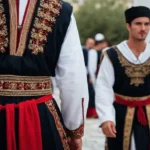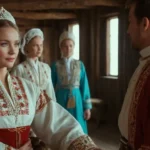Portugal, a country steeped in history and tradition, expresses its cultural identity through its traditional clothing, which varies across regions yet maintains a distinctive Portuguese charm.
From the rich embroidery of the Minho region to the iconic fisherwomen’s attire of Nazaré, these garments encapsulate the nation’s artistic heritage and connection to its roots. Whether worn during festivals, religious events, or weddings, Portuguese traditional clothing tells a story of craftsmanship and cultural pride.
The Historical Significance of Portuguese Traditional Clothing
Cultural Influences and Origins
Portuguese traditional clothing has evolved over centuries, shaped by a blend of Moorish, Roman, and European influences. The garments often reflect the country’s agrarian lifestyle and coastal geography, incorporating functional designs that double as artistic expressions.
Symbolism and Identity
Each region’s attire serves as a marker of local identity, with unique patterns, colors, and designs symbolizing community pride. Traditional clothing was often handmade, showcasing the wearer’s skill and social status.
See also Discovering the Elegance of Traditional Clothing in Greece
Discovering the Elegance of Traditional Clothing in GreeceKey Components of Portuguese Traditional Attire
Women’s Traditional Clothing
- Blouses and Bodices: White blouses with intricate lace or embroidery are common, often paired with fitted bodices in rich colors.
- Skirts: Layered, full skirts with vibrant patterns or stripes vary by region. Some areas favor solid colors with embroidered hems.
- Aprons: Ornate aprons with floral or geometric embroidery add an extra decorative layer.
- Shawls and Capes: Woolen or silk shawls, often adorned with fringe and embroidery, are essential for both style and warmth.
- Headwear: Women wear scarves or hats that vary in design, often indicating marital status or regional affiliation.
Men’s Traditional Clothing
- Shirts: Loose-fitting linen shirts, sometimes with minimal embroidery, form the base layer.
- Vests and Jackets: Tailored vests and short jackets, often made from wool, add structure and warmth.
- Trousers: High-waisted trousers in neutral tones are a staple, occasionally accessorized with belts or sashes.
- Footwear: Leather boots or clogs, depending on the region, complete the ensemble.
- Hats: Wide-brimmed felt hats or caps are a common accessory for men.
Accessories and Adornments
- Gold Jewelry: Particularly in northern Portugal, women often wear elaborate gold necklaces and earrings, symbolizing wealth and heritage.
- Scarves: Brightly colored scarves, worn as headpieces or neck coverings, add a touch of vibrancy.
- Belts and Sashes: Woven sashes provide additional flair and function.
Regional Variations in Portuguese Traditional Clothing
Minho
Minho’s traditional costumes are among the most recognizable in Portugal. Women wear vibrant, multi-layered skirts paired with embroidered blouses and gold jewelry. Men’s attire includes black trousers, white shirts, and vests with subtle embroidery.
Nazaré
Famous for its fisherwomen, Nazaré’s attire features colorful skirts worn in multiple layers (sometimes up to seven) and striped aprons. Women often wear headscarves and shawls, reflecting the town’s maritime heritage.
Alentejo
The clothing in Alentejo reflects the region’s rural lifestyle. Women wear simple, earth-toned dresses with aprons, while men don wool capes and broad-brimmed hats to protect against the elements.
Madeira
Traditional attire from Madeira includes striped woolen skirts for women and white linen shirts with short pants for men. Accessories like embroidered boots and colorful sashes add local flavor.
See also Discovering the Intricacies of Russian Folk Attire: A Glimpse into History and Tradition
Discovering the Intricacies of Russian Folk Attire: A Glimpse into History and TraditionAzores
In the Azores, traditional clothing is practical and suited to the island’s maritime climate. Women often wear dark skirts and shawls, while men favor sturdy jackets and boots.
Portuguese Traditional Clothing in Festivals and Celebrations
Religious Events
Religious festivals such as the Feast of Our Lady of Agony in Viana do Castelo showcase traditional clothing. Women wear richly embroidered garments and layers of gold jewelry during processions.
Cultural Festivals
- Festa de São João (Porto): Traditional attire is worn during parades and folk dance performances.
- Folk Dance Festivals: Across Portugal, dancers don regional costumes to celebrate their heritage.
Weddings
In rural areas, traditional clothing is still part of wedding ceremonies. Brides wear embroidered dresses and gold jewelry, while grooms opt for tailored vests and trousers.
The Art of Crafting Portuguese Traditional Clothing
Fabrics and Techniques
Traditional Portuguese clothing is made from natural materials such as linen, wool, and cotton. Hand-loomed fabrics and plant-based dyes are commonly used.
Embroidery and Detailing
Intricate embroidery is a hallmark of Portuguese attire, with patterns often inspired by local flora and fauna. The Minho region is particularly famous for its vibrant, detailed designs.
Goldsmithing
Northern Portugal is renowned for its goldsmithing tradition, with elaborate necklaces and filigree earrings being central to women’s traditional attire.
Preservation and Contemporary Adaptations
Cultural Preservation
Museums, cultural centers, and folklore groups work to preserve Portugal’s traditional clothing. Events like the International Folklore Festival in Viana do Castelo help keep these traditions alive.
Modern Influence
Contemporary designers in Portugal often draw inspiration from traditional clothing, incorporating elements such as embroidery and regional patterns into modern fashion.
Tourism and Heritage
Visitors to Portugal can explore traditional clothing at local markets, festivals, and museums. Artisan workshops offer opportunities to learn about the craftsmanship behind these garments.
A Living Tradition of Elegance and Culture
Portugal’s traditional clothing reflects its rich history, diverse regions, and enduring cultural pride. Whether experienced during vibrant festivals, admired in museums, or reimagined in contemporary fashion, these garments remain a cherished expression of Portuguese identity and artistry.
